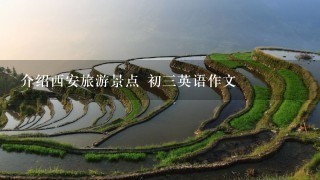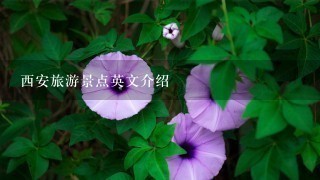西安旅游景点介绍麻烦帮我翻译成英文,介绍西安旅游景点 初三英语作文

1、西安旅游景点介绍麻烦帮我翻译成英文
Shaanxi is one of civilized important , all together China headstream, as far back as having Lantian Man to grow work here right away in the front for 1000000 years, starting from the 11th century B.C., successively have 13 in history dynasty found a capital here. Shaanxi Province field of being that our country cultural relics and historic sites gathers together , name of having "the natural history museum ": Acient Chang An county City historical remains, are known as eighth Shaanxi not only cultural relics and historic sites is a lot of , but also natural scene is beautiful: Have precipitous West Hua Mountain and Lin Tong Mt. black horse intelligent and elegant; Huanghe River kettle mouth waterfall having rapids to surge; Still have the organism's habits tourist area giving first place to protecting a giant panda waiting for a rare animal. Not only northern Shaanxi highland be Chinese revolution base area , but also be Shaanxi folk custom local manners and feelings headstream: Shaanxi opera loud and sonorous , vehement gong and drum , consummate paper-cut and extremely rich life breath peasant painting etc. , the sight having attracted more and more many attention's all with it's culture thick and heavy bottom rhyme and distinctive loess amorous feeling. largest in the world miracle Qin Shi Huang's Buried Sculpture Legion , grand grand sight 72 emperors mausoleum big or small, ... Distant vast China civilization makes everyone first the people who arrives at Shaanxi not excavate heart profundity meditating on the past conscientiously swinging thought.。

2、介绍西安旅游景点 初3英语作文
***.at the moment you walk into the gate of the park,the towering trees are welcoming you warmly with their luxuriant leave at each side of road.walking inside,you'll find a rockery garden line up with various kind of lovely posture,beckoning you walk nearer for appreciation.besides road ,the transparent lake is beating her waves at times as if welcome the tourist.while you overlook the landscape,the boundless lake is surrounding the hills and land makes you wonder the beauty of natural!xuanwu lake a unique scenery in Nanjin。

3、西安旅游景点英文介绍
Big Wild Goose Pagoda Originally built in 652 during the reign of Emperor Gaozong of the Tang Dynasty (618-907), it functioned to collect Buddhist materials that were taken from India by the hierarch Xuanzang. Xuanzang started off from Chang'an (the ancient Xian), along the Silk Road and through deserts, finally arriving in India, the cradle of Buddhism. Enduring 17 years and traversing 100 countries, he obtained Buddha figures, 657 kinds of sutras, and several Buddha relics. Having gotten the permission of Emperor Gaozong (628-683), Xuanzang, as the first abbot of Da Ci'en Temple, supervised the building of a pagoda inside it. With the support of royalty, he asked 50 hierarchs into the temple to translate Sanskrit in sutras into Chinese, totaling 1,335 volumes, which heralded a new era in the history of translation. Based on the journey to India, he also wrote a book entitled 'Pilgrimage to the West' in the Tang Dynasty, to which scholars attached great importance. First built to a height of 60 meters (197 feet) with five stories, it is now 64.5 meters (211.6 feet) high with an additional two stories. It was said that after that addition came the saying-'Saving a life exceeds building a seven-storied pagoda'. Externally it looks like a square cone, simple but grand and it is a masterpiece of Buddhist construction. Built of brick, its structure is very firm. Inside the pagoda, stairs twist up so that visitors can climb and overlook the panorama of Xian City from the arch-shaped doors on four sides of each storey. On the walls are engraved fine statues of Buddha by the renowned artist Yan Liben of the Tang Dynasty. Steles by noted calligraphers also grace the pagoda. As for the reason why it is called Big Wild Goose Pagoda, there is a legend. According to ancient stories of Buddhists, there were two branches, for one of which eating meat was not a taboo. One day, they couldn't find meat to buy. Upon seeing a group of big wild geese flying by, a monk said to himself: 'Today we have no meat. I hope the merciful Bodhisattva will give us some.' At that very moment, the leading wild goose broke its wings and fell to the ground. All the monks were startled and believed that Bodhisattva showed his spirit to order them to be more pious. They established a pagoda where the wild goose fell and stopped eating meat. Hence it got the name 'Big Wild Goose Pagoda'. The Terracotta Army (Chinese: 兵马俑; Pinyin: Bīng Mǎ Yǒng; literally "military servants") or Terra-cotta Warriors and Horses is a collection of 8,099 life-size terra cotta figures of warriors and horses located in the Mausoleum of the First Qin Emperor (秦始皇陵; Qín Shǐ Huáng Líng). The figures were discovered in 1974 near Xi'an, Shaanxi province, The terracotta figures were buried with the first Emperor of Qin (Qin Shi Huang) in 210-209 BC. Consequently, they are also sometimes referred to as "Qin's Army." The Terracotta Army of China was discovered in March 1974 by local farmers drilling a well to the east of Mount Li. Mount Li is the name of the man-made necropolis and tomb of the First Emperor of Qin; Qin Shi Huang. Construction of this mausoleum began in 246 B.C. and is believed to have taken 700,000 workers and craftsmen 36 years to complete. Qin Shi Huang was interred inside the tomb complex upon his death in 210 B.C. According to the Grand Historian Sima Qian, The First Emperor was buried alongside great amounts of treasure and objects of craftsmanship, as well as a scale replica of the universe complete with gemmed ceilings representing the cosmos, and flowing mercury. representing the great earthly bodies of water. Recent scientific work at the site has shown high levels of mercury in the soil of Mount Li, tentatively indicating an accurate description of the site’s contents by Sima Qian. The tomb of Qin Shi Huang is near an earthen pyramid 76 meters tall and nearly 350 meters square. The tomb presently remains unopened. There are plans to seal-off the area around the tomb with a special tent-type structure to prevent corrosion from exposure to outside air. However, there is at present only one company in the world that makes these tents, and their largest model will not cover the site as needed. Qin Shi Huang’s necropolis complex was constructed to serve as an imperial compound or palace. It is comprised of several offices, halls and other structures and is surrounded by a wall with gateway entrances. The remains of the craftsmen working in the tomb may also be found within its confines, as it is believed they were sealed inside alive to keep them from divulging any secrets about its riches or entrance. It was only fitting, therefore, to have this compound protected by the massive terra cotta army interred nearby.。

4、西安旅游景点介绍?
第
1、2天:兵马俑、秦始皇陵、华清池、华山 1.在西安火车站东广场(火车站售票口前面)坐游5(306)路到兵马俑下。 提示:游5(306)路车辆拥有标准的外形。灰色黄海大巴门徽上印制着“西安公共交通总公司”标志,前挡风玻璃顶端有“306工人先锋号”标志,风挡上侧印有“缓堵保畅”字样。司乘人员身穿的公交制服,右臂上有蓝色标识的星牌。每辆车都按规定路线行驶,车上会有乘务员按标准进行普通话和哑语报站,用英语进行沿途景点介绍。正规游5等车时要排队上车,到车上才买票,尤其是不会提前售票,不售往返票。广场上有很多游5(306)路黑车,千万不要坐,以免上当。 现在秦始皇帝陵博物院是通票(包括秦始皇兵马俑博物馆、秦始皇陵、秦始皇陵遗址公园、百戏俑坑博物馆、石铠甲博物馆。博物院内交通不收费,即游客乘坐院内交通工具不再收费)。 2.参观完兵马俑,在兵马俑坐307路、914路、游5(306)路,华清池下。浏览华清池。 华清池内主要景点:芙蓉园、唐御汤遗址、贵妃池、梨园、唐代水井、骊山温泉、碑海书林、9龙湖、5间厅等。 注意:在临潼吃饭时小心被宰,吃饭前先看好菜单价格。最好找有笑脸标志的饭馆(现在临潼所有的饭馆分为3种,都有标志)。 3.游览完华清池后,你在临潼汽车站坐长途汽车去华山,汽车从临潼到华山1般不到3个小时。当天晚上爬华山。我这样安排,你不用跑冤枉路还可以省1天的住宿费。 4.第2天下午5点在华山坐西安游1路公交车(票价22元)返回西安。 第3天、4天:法门寺、昭陵、乾陵 1.在西安火车站东广场(火车站售票口前面)坐游2路(每天只有早8点1班)到法门寺。 2.参观完法门寺,在法门寺坐车到扶风,在扶风县城坐开往礼泉、乾县、永寿、彬县的车,在礼泉县城下车,换开往烟霞、北屯方向的车,到昭陵博物馆下。参观完昭陵后在礼泉坐车乾县。在礼泉或乾县住1夜。 3.参观完乾陵在乾县坐车回西安(从乾陵回西安的游3是下午3点在乾陵发车)。 法门寺美食:豆腐脑、浇汤面、馇酥、锅盔馍夹辣子、岐山哨子面。 法门寺特产:法门寺素饼、鹿糕京、秦淑、凤党、5味子、岐山稍子面、腊驴肉、马勺脸谱、罩金漆器、木板年画等。 注:最好到乾县住。乾县的锅盔很有名,可以放1个星期都不会坏。在乾县吃羊肉泡馍(用乾县锅盔)别有1番滋味。 第
5、6天:陕西省历史博物馆、大雁塔、大唐芙蓉园、曲江海洋馆、寒窑、曲江遗址公园、大雁塔北广场、小雁塔(西安博物院)、西安碑林博物馆、明城墙、钟楼、鼓楼、钟鼓楼广场、回民1条街 1.(第1天)现在陕西省历史博物馆免费了。推荐先去省博是因为省博现在免费但不免票(带上有效身份证件领票)。每天参观得人比较多,不早点去,领票排队时间比较长。坐公交在翠华路下。 2.参观完陕博可以坐公交到大雁塔南广场下进大雁塔。 3.游览完大雁塔,在大雁塔南广场坐公交到大唐芙蓉园下,进大唐芙蓉园。 4.从大唐芙蓉园南门出,在大唐芙蓉园南门坐601路、游8(610)路,曲江海洋世界下。进曲江海洋馆。 5.在曲江海洋世界坐601路、游8(610)路,大唐芙蓉园南门下,往东(回)到曲江遗址公园。 6.从曲江遗址公园到寒窑(王宝钏等薛仁贵居住十8年的地方)。 7.参观完寒窑后,在寒窑路西口坐22路,大雁塔下。到大雁塔北广场看音乐喷泉(大雁塔北广场音乐喷泉是亚洲第1大音乐喷泉。最好看晚上8点半那1场,有音乐和灯光)。 8.(第2天)坐公交在小雁塔下。进西安博物院。 9.在小雁塔坐5龙专线、40路,文昌门下,进文昌门是就是碑林博物馆。 10.参观碑林博物馆。可以顺着碑林南围墙1直往西走到书院门步行街(书院门步行街都是书法和1些手工制品,1般看看就行了,不要买。如果实在想买的话,只调1些小玩意买,小心被宰哟)到南门,从南门上明城墙。 11.下城墙后,坐公交或走到钟楼。下钟楼地下通道购票上钟楼,游览完钟楼从钟鼓楼广场到鼓楼(建议上了钟楼就不要上鼓楼),游览完鼓楼后,可以从鼓楼两面往北进回民1条街。哪里是西安回民小吃最全的地方。 12.如果时间富裕,可以到钟楼东面东大街200米的骡马市步行街。





































































